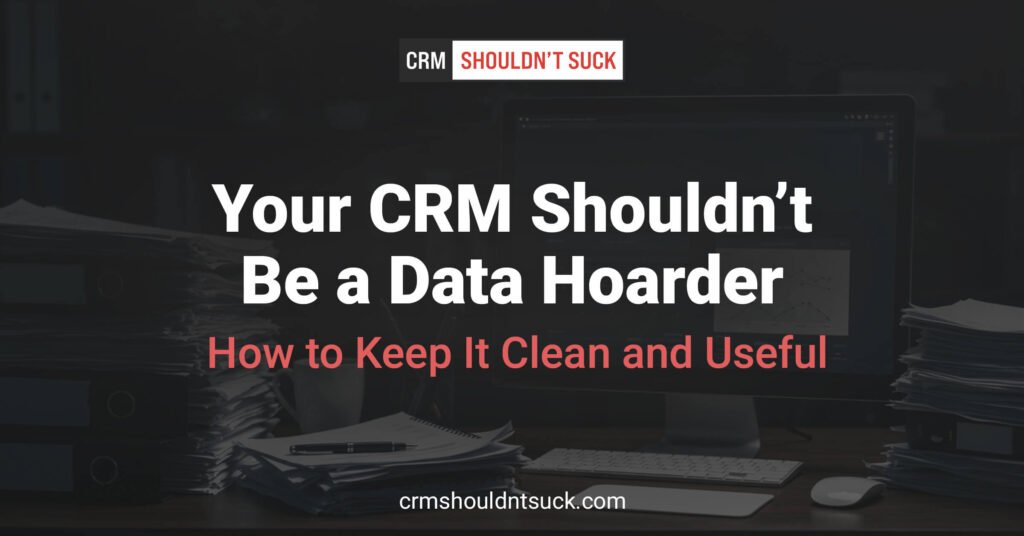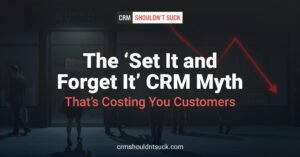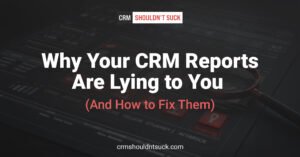The Hidden Cost of a Messy CRM
Every sales leader has faced the nightmare of logging into their CRM, only to be greeted by a bloated, disorganized mess of outdated contacts, duplicate records, and incomplete data. Sales reps waste hours sifting through bad information, pipeline reviews are riddled with inaccuracies, and leadership can’t trust the reports guiding strategic decisions.
The problem isn’t just frustrating—it’s expensive. Poor CRM data hygiene leads to lost revenue opportunities, decreased efficiency, and declining adoption as frustrated users abandon the system. The CRM should be a powerhouse of insight, not a graveyard of useless records.
If your CRM feels more like a hoarder’s attic than a high-performance sales tool, it’s time to clean house. Here’s how to keep your CRM data clean, accurate, and useful.
Step 1: Define What Data Actually Matters
The Mistake: Many companies collect everything, hoping it will be useful someday. The result is a cluttered CRM filled with irrelevant, redundant, or outdated information.
The Fix: Establish clear guidelines on what data is essential and what should be discarded. Consider:
- What key fields must be completed for a lead or contact to be valid?
- How long should inactive contacts remain before being archived or deleted?
- Which data points actually contribute to sales and marketing decisions?
By defining these rules, you ensure that your CRM remains a source of valuable, actionable insights rather than a repository of digital clutter.
Step 2: Cleanse Your Data Regularly
The Mistake: Companies wait until the CRM is unusable before initiating a cleanup effort, leading to massive, time-consuming data scrubbing projects.
The Fix: Schedule routine data hygiene checks to keep the system in shape. A proactive approach includes:
- Running monthly reports to identify and merge duplicate records
- Purging outdated or inactive contacts
- Verifying and standardizing data formats (phone numbers, email addresses, job titles, etc.)
- Updating missing or incomplete information
Consider assigning a dedicated data steward or using automation tools to flag inconsistencies before they become a problem.
Step 3: Eliminate Duplicate Records
The Mistake: Duplicate entries are one of the biggest culprits in CRM inefficiency. They cause confusion, lead to multiple sales reps working the same lead, and result in unreliable reporting.
The Fix: Prevent duplication at the source by enforcing:
- Strict data entry rules requiring users to check for existing records before creating new ones
- Automated duplicate detection and merging tools
- Standardized naming conventions to ensure consistency
Regularly reviewing and consolidating duplicate records keeps the CRM organized and prevents sales teams from stepping on each other’s toes.
Step 4: Automate Data Validation
The Mistake: Relying on manual data entry leads to errors, inconsistencies, and missing critical information.
The Fix: Implement automation to validate and enrich data in real-time. This can include:
- Integrations with third-party databases for real-time verification of contact details
- Required field validation to prevent incomplete entries
- AI-driven data enrichment to keep records up-to-date with job changes, company shifts, and new contact information
Automation ensures that your CRM stays accurate without requiring constant manual intervention.
Step 5: Align CRM Usage with Business Goals
The Mistake: When sales, marketing, and customer success teams operate in silos, CRM data quickly becomes fragmented and unreliable.
The Fix: Ensure all teams understand the strategic importance of CRM data and how it supports business objectives. This means:
- Aligning data entry standards across all departments
- Creating shared dashboards and reports that reflect key business metrics
- Conducting ongoing training to reinforce best practices
A CRM that serves the entire organization, not just one department, is far more likely to maintain high data integrity.
Step 6: Make CRM Hygiene Non-Negotiable
The Mistake: Sales reps often see data entry as a low-priority administrative task, leading to gaps, errors, and outdated information.
The Fix: Make data hygiene a core expectation by:
- Setting clear accountability for keeping records updated
- Rewarding good data habits with incentives tied to accurate pipeline management
- Tying CRM adoption to performance evaluations and compensation
Sales leaders who prioritize clean data create a culture where the CRM is a trusted resource rather than a dumping ground.
Step 7: Audit and Improve Continuously
The Mistake: CRM hygiene is treated as a one-time project rather than an ongoing process.
The Fix: Build continuous improvement into your CRM strategy by:
- Conducting quarterly data audits
- Gathering feedback from sales and marketing teams on CRM usability
- Implementing regular process refinements to keep data collection efficient and relevant
A CRM should evolve with your business. The more you refine and optimize data management, the more valuable your CRM becomes as a strategic asset.
Conclusion: A Clean CRM is a High-Performing CRM
Your CRM should be the engine that powers revenue growth, not an administrative burden that sales teams avoid. By focusing on data hygiene, automation, and alignment with business goals, you transform the CRM into a system that sales teams trust, leadership relies on, and marketing leverages for precision-targeted outreach.
The choice is simple—either control your CRM data, or let it control you. Make the commitment to keep your CRM clean, and watch as efficiency, accuracy, and adoption rates soar.



